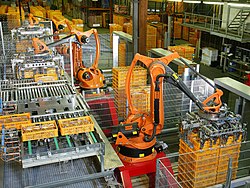Benefits of logistics automation
A typical warehouse or distribution center will receive stock of a variety of products from suppliers and store these until the receipt of orders from customers, whether individual buyers (e.g. mail order), retail branches (e.g. chain stores), or other companies (e.g. wholesalers). A logistics automation system may provide the following:
- Automated goods in processes: Incoming goods can be marked with barcodes and the automation system notified of the expected stock. On arrival, the goods can be scanned and thereby identified, and taken via conveyors, sortation systems, and automated cranes into an automatically assigned storage location.
- Automated Goods Retrieval for Orders: On receipt of orders, the automation system is able to immediately locate goods and retrieve them to a pick-face location.
- Automated dispatch processing: Combining knowledge of all orders placed at the warehouse the automation system can assign picked goods into dispatch units and then into outbound loads. Sortation systems and conveyors can then move these onto the outgoing trailers.
- If needed, repackaging to ensure proper protection for further distribution or to change the package format for specific retailers/customers.
A complete warehouse automation system can drastically reduce the workforce required to run a facility, with human input required only for a few tasks, such as picking units of product from a bulk packed case. [1] Even here, assistance can be provided with equipment such as pick-to-light units. Smaller systems may only be required to handle part of the process. Examples include automated storage and retrieval systems, which simply use cranes to store and retrieve identified cases or pallets, typically into a high-bay storage system which would be unfeasible to access using fork-lift trucks or any other means. The use of Automatic Guided Vehicles maximizes the output compared to humans since they can do repetitive tasks for long hours and with least to no supervision. An AGV is built and programmed for precision and accuracy thereby reducing the chances of errors in a warehouse, especially when dealing with fragile goods. [2]
Automation software
Software or cloud-based SaaS solutions are used for logistics automation which helps the supply chain industry in automating the workflow as well as management of the system. [3] Knowledge @ Wharton staff writers noted in 2011 that some manufacturers and retailers were weathering the Great Recession "by signing up for pay-as-you-go logistics services available through the Internet 'cloud'". They identified the benefits and reduced costs which came from sharing information about shipments with suppliers, hauliers and end users. [4]
There is little generalized software available in this market. This is because there is no rule to generalize the system as well as work flow even though the practice is more or less the same. Most of the commercial companies do use one or the other of the custom solutions.
But there are various software solutions that are being used within the departments of logistics. There are a few departments in Logistics, namely: Conventional Department, Container Department, Warehouse, Marine Engineering, Heavy Haulage, etc.
- Software used in these departments
- Conventional department : CVT software / CTMS software.
- Container Trucking: CTMS software
- Warehouse : WMS/WCS
- Improving Effectiveness of Logistics Management
- Logistical Network
- Information
- Transportation
- Sound Inventory Management
- Warehousing, Materials Handling & Packaging
This page is based on this
Wikipedia article Text is available under the
CC BY-SA 4.0 license; additional terms may apply.
Images, videos and audio are available under their respective licenses.




